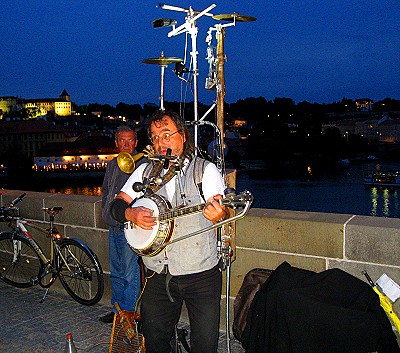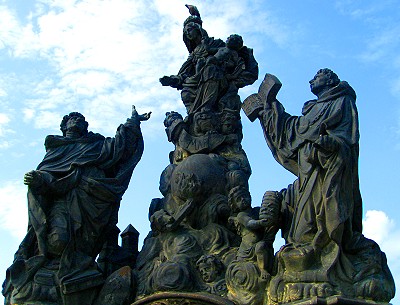
From the earliest days of Prague, this bridge across the Vltava River has been the focal point of the city.
In fact the name itself, Praha, is from the Slavic word, praga, meaning ford.
No, not the maker of cars, but as in the crossing of a river.
Since it’s much easier to traverse a torrent on a bridge than in the stream, King Vladislaus II built the first bridge in 1170.
In 1342, when the original structure was washed away in a flood, King Charles IV replaced it with the more jammin’ version that stands today.
Originally just called the Stone Bridge, over the years it became known as the Charles Bridge, in honor of good ol’ king Chuck.
For about five hundred years this was the only way across the Vltava, now there are several others, but we never once considered using any of those for our crossing.
That’s because the Charles is much more than just a bridge, it’s a history lesson, a performance venue, a shopping center and a place for supernatural phenomenon.
As soon as we crossed through the famous Gothic Old Town Guard Towers we realized that the Charles Bridge serves as Prague’s pedestrian mall (no cars allowed since 1965), flea market and street performance Mecca.
Both railings of the bridged are lined with entertainers and artists, all trying to make a Koruna or two.

Musicians, singers, magicians and mimes put on a nonstop show for the thousands of tourists that file by each day.
Mingled in among the performers are various fine artists, also vying for a couple Czech bucks from the crowd.
Their works run from serious to silly with portraits, caricatures, scenes of Prague or jewelry, crafts and souvenirs all up for sale.
We hadn’t come to shop, so we managed to pass over the viaduct unscathed by these peddlers and pitchmen, save for the monetary tributes we left for the musicians. We’re huge suckers for a novel street performance.

We came to the Charles Bridge for the history and supernatural, which are entirely intertwined.
Our curiosity was aroused by legends of the statues that flank both sides of bridge.
Certain brass spots on some of the sculptures have been rubbed by passersby to a brightly polished shine.
These spots often have people lined up waiting for a touch.

In the late sixteen and early seventeen hundreds thirty statues of various saints, knights and a crucifix, were erected along the railings of the bridge.
The rendering of St. John of Nepomuk quickly became the most famous – hands down.
St. John was martyred on this very bridge in 1393 and became the patron saint of Prague. It seems that John, as bishop of the city, and Wenceslaus, King of Bohemia and the Holy Roman Empire, had a few religious disagreements.
These kind of disputes rarely turned out well for the Johns of the world.


As is often the case, history and legend diverge a bit on just what happened.
History states that John and the king couldn’t see eye-to-eye on the appointment of a new bishop so Wenceslaus decided to get him out of the picture by tossing him off the bridge.
The legend has it that John had been hearing the queen’s confessions and the king, being the suspicious sort, wanted to know what she had been confessing.
John was unwilling to break the confidentiality of the confessional, so the Wenceslaus had him chucked off the Charles Bridge.
This made him an instant hero and martyr for the church, helping assure the flock that what happened in the confessional stayed in the confessional. The story further claims that as he entered the water, stars appeared and remained just above the surface.
He was made a saint in no time flat.

This brings us to the superstitions that we observed, the rubbing of the brass as a way to a make wish come true or to ensure a return to Prague.
Even though the statues were replaced with replicas in the 1960s, the traditions continue undeterred. No word on if the replacements contain equal magical powers as the originals but certainly plenty of people are giving it a shot.

The exact spot on the bridge where St. John was thrown into the Vltava is marked with a small brass cross with five stars above it, depicting the stars that hung over the water that fateful night.
To make a wish come true, one must reach for the stars, touching one star for each finger tip, while sending a petition to the cosmos. All of this touching keep the stars perfectly polished.

On the nearby statue of St. John of Nepomuk, a plaque on the base depicts the scene as he was tossed over the side of the bridge while the queen is forced to watch.
Rubbing the image of St. John plummeting off the edge ensures that the person doing the rubbing will one day return to Prague.
We rubbed several times each, no use taking any chances.

Another plaque on the same base shows a knight and his faithful hound.
After asking around and further reseach, we couldn’t find what power the dog might possess, yet he had been burnished to a blinding gleam.
As near as we could figure, it’s just because he’s cute.
We gave him a pat, too.
Good dog.
David & Veronica, GypsyNester.com
See all of our adventures in Prague!
Can’t get enough of the Czech Republic? We have much more for you!



Yes, one of the most visited statues on the Charles bridge is the Statue of St.St. John of Nepomuk, the base of the statue has a brass depiction of a dog, that people touch for good luck(don’t put your fingers in your mouth after you do so, because a lot of other people touch it)
The statue is there as a part of the counter-reformation in the 1650, when the Catholics managed to subdue the budding Protestant movement. St, John was invented or brought into fashion as a pious and faithful saint whose morality and growing legend could rival the personality of the Good Prince Wenceslaus-St. Wenceslaus, who we know from the Christmas carroll.
Under his statue on the Charles bridge is is a plaque depicting his deeds, by legend he was the private confession priest of the daughter in law of Charles IV, one day she confessed something to the St. John and her husband Wenceslaus IV, the son of Charles IV, was jealous and wanted to find out what she has confessed, so he summoned St. John who wouldn’t tell him what his wife had confessed to hims, so he had his tongue cut out , and thrown off the Charles bridge- people touch the dog for good luck, that they will return to Prague, because a dog symbolizes loyalty , like St. John who was loyal to his priestly promise of confidentiality not to reveal what was being confessed to him.
Thanks for the great info Rob.
Nice article! best regards from Czechia!
http://www.go-czechia.com
Joe
If someone had asked me to tell them a secret on pain of death, I would’ve just lied LOL. Still it’s nice to hear of times when stars appeared to honor those with moral codes. Fascinating post (and pics), ‘nesters!
Thanks Lesley! It was a different time.
Aww, I miss Prague already. We got engaged here on the Charles Bridge. Talk about supernatural.. lol
Wow, great place to get engaged!
This sort of reminds me of the Ponte Vecchio in Florence, just in terms of importance to the city and all of the crowds. I love all of the superstitions on the Charles Bridge though.
You’re right about the bridge and had fun with the superstitions. We love Florence too and Ponte Vechio is a big part of it.